R.J. Stowell's Blog: rjsomeone, page 70
June 3, 2018
On "Blue Monday"
 "Blue Monday" (AM10), Produced by New Order; Engineered by Michael Johnson assisted by Barry Sage and Mark Boyne. A Factory Record (FAC73); Released March 7, 1983.
"Blue Monday" (AM10), Produced by New Order; Engineered by Michael Johnson assisted by Barry Sage and Mark Boyne. A Factory Record (FAC73); Released March 7, 1983.Gillian Gilbert (Synths) on "Blue Monday:" In 1983, before computers came along, it wasn't easy to do electronic bass lines and rhythms. So Bernard Sumner started building these gadgets called sequencers. Next, we thought it would be good to create a song that was completely electronic. Blue Monday's distinctive intro was written on an Oberheim DMX drum machine. We'd been going to clubs in New York and wanted to recreate the fantastic bass-drum sounds we'd heard. We tried to play something like Donna Summer's Our Love and came up with that instantly recognizable thud.
 The synthesiser melody is slightly out of sync with the rhythm. This was an accident. It was my job to programme the entire song from beginning to end, which had to be done manually, by inputting every note. But I accidentally left a note out, which skewed the melody. We'd bought ourselves an Emulator 1, an early sampler, and used it to add snatches of choir-like voices from Kraftwerk's album Radioactivity, as well as recordings of thunder..."Blue Monday" was meant to be robotic, the idea being that we could walk on stage and do it without playing the instruments ourselves. We spent days trying to get a robot voice to sing "How does it feel?" but somebody wiped the track. Bernard ended up singing it.
The synthesiser melody is slightly out of sync with the rhythm. This was an accident. It was my job to programme the entire song from beginning to end, which had to be done manually, by inputting every note. But I accidentally left a note out, which skewed the melody. We'd bought ourselves an Emulator 1, an early sampler, and used it to add snatches of choir-like voices from Kraftwerk's album Radioactivity, as well as recordings of thunder..."Blue Monday" was meant to be robotic, the idea being that we could walk on stage and do it without playing the instruments ourselves. We spent days trying to get a robot voice to sing "How does it feel?" but somebody wiped the track. Bernard ended up singing it. We couldn't believe it when it became the biggest-selling 12-inch of all time. People have interpreted the title all sorts of ways. It actually came from a book Stephen was reading, Kurt Vonnegut's Breakfast of Champions. One of its illustrations reads: "Goodbye Blue Monday." It's a reference to the invention of the washing machine, which improved housewives' lives.

Peter Saville (Sleeve Design) on "Blue Monday:" I met New Order in their Manchester studio to show them a postcard of the Henri Fantin-Latour flower painting I was using for the cover of their forthcoming album Power, Corruption and Lies. While I was there, they played me "Blue Monday," and I instinctively understood what they were trying to do. It sounded like something the equipment could play itself.
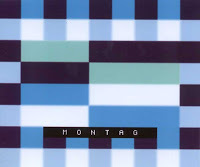 I picked up an interesting object and asked: "Wow, what is this?" I'd never seen a floppy disk before. I thought it was great. I said: "Can I have it?" And Stephen said: "Not that one!" So I drove back to London listening to a tape of "Blue Monday" with another floppy disk lying on the passenger seat. By the time I got home, I knew the sleeve would replicate a floppy disk, with three holes cut in it through which you could see the metallic inner sleeve. The only information I had to impart were the words New Order, the song titles (including B-side The Beach) and the Factory Records catalogue number. I decided to do this with a column of coded colours, to provide some mysterious data, so I sat down with some pencils and used a different colour for each letter.
I picked up an interesting object and asked: "Wow, what is this?" I'd never seen a floppy disk before. I thought it was great. I said: "Can I have it?" And Stephen said: "Not that one!" So I drove back to London listening to a tape of "Blue Monday" with another floppy disk lying on the passenger seat. By the time I got home, I knew the sleeve would replicate a floppy disk, with three holes cut in it through which you could see the metallic inner sleeve. The only information I had to impart were the words New Order, the song titles (including B-side The Beach) and the Factory Records catalogue number. I decided to do this with a column of coded colours, to provide some mysterious data, so I sat down with some pencils and used a different colour for each letter.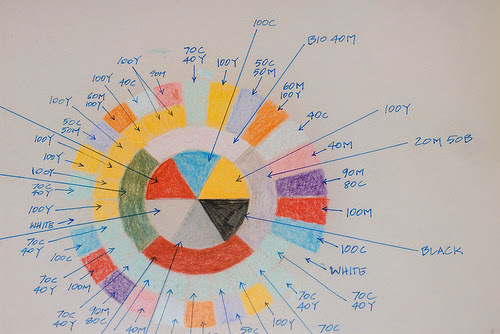
Published on June 03, 2018 05:40
June 2, 2018
New Order
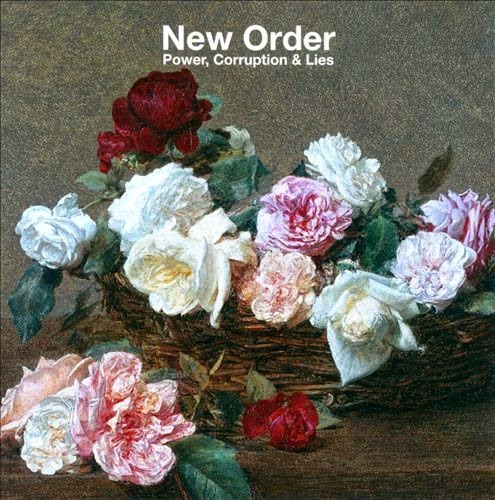 Power, Corruption and Lies
(AM9), American Issue (includes "The Beach" and "Blue Monday")Artist: New OrderRelease: May 2, 1983Label: Factory (Factus 12)Producer: New OrderLength: 57:14Tracks: 1) "Age of Consent" (5:16); 2) "We All Stand" (5:14); 3) "The Village" (4:37); 4) 5 8 6 (7:31); 5) Blue Monday (7:32); 6) "Your Silent Face" (6:00) 7) Ultraviolence (4:52); 8)"Ecstacy" (4:25); 9) "Leave Me Alone" (4:40); 10) "The Beach" (7:22)Personnel: Bernard Sumner, vocals, guitars, melodica, synthesizers and programming; Peter Hook, 4- and 6-stringed bass, electronic percussion; Stephen Morris, drums, synthesizers and programming; Gillian Gilbert – synthesizers and guitars
Power, Corruption and Lies
(AM9), American Issue (includes "The Beach" and "Blue Monday")Artist: New OrderRelease: May 2, 1983Label: Factory (Factus 12)Producer: New OrderLength: 57:14Tracks: 1) "Age of Consent" (5:16); 2) "We All Stand" (5:14); 3) "The Village" (4:37); 4) 5 8 6 (7:31); 5) Blue Monday (7:32); 6) "Your Silent Face" (6:00) 7) Ultraviolence (4:52); 8)"Ecstacy" (4:25); 9) "Leave Me Alone" (4:40); 10) "The Beach" (7:22)Personnel: Bernard Sumner, vocals, guitars, melodica, synthesizers and programming; Peter Hook, 4- and 6-stringed bass, electronic percussion; Stephen Morris, drums, synthesizers and programming; Gillian Gilbert – synthesizers and guitars Out of the ashes of Joy Division came New Order in the most seamlessly impressive musical reinvention in rock (outside of Bowie), but it wouldn't happen until their 2nd LP, Power, Corruption and Lies, an album which defines the synth-pop dynamic for the 80s. Though the sound is dominated by synthesizers and bass, Bernard Sumner's melodic and decidedly subdued vocals and guitar ensured that this record would be the most human synth-pop album of the era. Sumner may not have been anywhere near as mesmerizing as Ian Curtis, but New Order wasn't about that. New Order was the picture perfect team; a group in which each member was never above passing the ball, and no one ever dominated a song. Movement (AM7), with its dark, moody ambiguiety could be found virtually nowhere on Power, Corruption and Lies, the ideology was there and the lyrics were as profound (if understated) as ever (Pet Shop Boys come to mind), but this true 80s' expression through dance music, the precursor to EDM and rave and trip-hop, but with substance. Joy Division invented Shoegaze and New Order abandoned it at its pinnacle.
Out of the ashes of Joy Division came New Order in the most seamlessly impressive musical reinvention in rock (outside of Bowie), but it wouldn't happen until their 2nd LP, Power, Corruption and Lies, an album which defines the synth-pop dynamic for the 80s. Though the sound is dominated by synthesizers and bass, Bernard Sumner's melodic and decidedly subdued vocals and guitar ensured that this record would be the most human synth-pop album of the era. Sumner may not have been anywhere near as mesmerizing as Ian Curtis, but New Order wasn't about that. New Order was the picture perfect team; a group in which each member was never above passing the ball, and no one ever dominated a song. Movement (AM7), with its dark, moody ambiguiety could be found virtually nowhere on Power, Corruption and Lies, the ideology was there and the lyrics were as profound (if understated) as ever (Pet Shop Boys come to mind), but this true 80s' expression through dance music, the precursor to EDM and rave and trip-hop, but with substance. Joy Division invented Shoegaze and New Order abandoned it at its pinnacle.Purists will insist that "The Beach" and "Blue Monday" do not belong (they are not on the UK release), but New Order was a band of excesses: excessive intros, excessive instrumental bridges, excessive counterpoint, and throughout their career (with the exception of Movement, which again is more of a Joy Division album in the way the Trick of the Tail emulates Peter Gabriel's Genesis), the philosophy was far from less is more; it was more is more, it was excess is more. Power, Corruption and Lies is the sign of a band coming into its own after great adversity. The suicide of Ian Curtis was not just the loss of a lead singer for an underground powerhouse; for Sumner, Hook and Morris, it was the loss of a dear, troubled friend. New Order's first album Movement is a funereal, grim LP that shows the band had still not come to grips with this loss. Power, Corruption and Lies instead has become the most ripped off album of the decade, if not of all time, and one of the finest of the 80s.
Among the best, "We All Stand" is five minutes of pure electronic melancholia. "Your Silent Face" is ballad-esque and showcases New Order's penchant for subtle beauty among these synthesized dance tracks. But the showcase tune, "Leave Me Alone" is pure, moody solitude. Bernard Sumner rolls the song along slowly at first, but the urgency in his voice elevates as his "character" becomes increasingly frustrated in his inability to escape the company of others. The lyrics keep in line with New Order’s usual sexual despondence:
From my head to my toesTo my teeth, through my nose,You get these words wrongYou get these words wrong, every time,You get these words wrong.I just smile.
Published on June 02, 2018 04:09
June 1, 2018
New Order - Movement
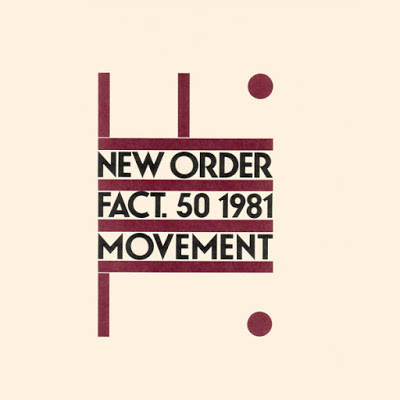 Movement is New Order's first album, but it occupies an odd space. After Ian Curtis committed suicide in 1980, the remaining members of Joy Divison were left with the decision to either call it a day or move on, opting for the latter, with Movement representing the band's growing pains. Essentially, Movement is a Joy Division album without Ian Curtis. Curtis' ghost haunts the album, and how couldn't it? He died just a year before, and the wounds hadn't closed. A handful of songs on the album directly reference him ("The Him," "I.C.B."), and with no clear frontman, Peter Hook spent much of his co-frontman duties trying to sound as much like Curtis as possible. (Bernard Sumner, for his part, sounded pretty much the same as he does now, just a lot younger.) I'm making it sound as if Movement isn't one of my favorite LPs of both JD and NO. Maybe I was in a transition phase and the LP just worked for me, but I've been defending this LP for years. I'm not sure why I've had to with songs like "Dreams Never End" rivaling anything in the two bands' catalog. New Order would, of course, go on to be less JD/Cure-ish and into the incredibly moribund dance band we all love, but Movement is the band's Rubber Soul, moving away from one era, but not yet immersed in the next.
Movement is New Order's first album, but it occupies an odd space. After Ian Curtis committed suicide in 1980, the remaining members of Joy Divison were left with the decision to either call it a day or move on, opting for the latter, with Movement representing the band's growing pains. Essentially, Movement is a Joy Division album without Ian Curtis. Curtis' ghost haunts the album, and how couldn't it? He died just a year before, and the wounds hadn't closed. A handful of songs on the album directly reference him ("The Him," "I.C.B."), and with no clear frontman, Peter Hook spent much of his co-frontman duties trying to sound as much like Curtis as possible. (Bernard Sumner, for his part, sounded pretty much the same as he does now, just a lot younger.) I'm making it sound as if Movement isn't one of my favorite LPs of both JD and NO. Maybe I was in a transition phase and the LP just worked for me, but I've been defending this LP for years. I'm not sure why I've had to with songs like "Dreams Never End" rivaling anything in the two bands' catalog. New Order would, of course, go on to be less JD/Cure-ish and into the incredibly moribund dance band we all love, but Movement is the band's Rubber Soul, moving away from one era, but not yet immersed in the next. The mood of the music is understandably bleak, given the proximity of its recording to Ian Curtis' death the year before. Part of this bleakness, however, stems from the aimlessness that came with Joy Division having lost its voice before New Order found its own. Movement is synth-heavy in the same way that the second half of Closer is: that is, the keyboard is a ponderous instrument with very little mobility that serves to create atmosphere more than to lead the melodic progression. One of the few songs that gives any hint of the New Order to come is the underrated fourth track "Chosen Time." The song is fast-moving, features Peter Hook's bass taking the dominant melodic role, and has the keyboard as a rhythmic motivator. The meaning behind the name "ICB" is that it's an abbreviation for "Ian Curtis Buried," which he most certainly was not at the time of the album's recording. Peter Hook and Bernard Sumner both ape Curtis' disaffected, isolated singing style throughout the course of the album. The way Sumner sings "Denial" sounds almost exactly like the way Ian Curtis sang "Wilderness" on Unknown Pleasures, and Hook's moody performance on the otherwise strong "Doubts Even Here" is aesthetic plagiarism.
The problem is this: on what should have been a transition album, there was no transition. New Order was still writing Joy Division songs without one of Joy Division's key elements, you know, Curtis. As a result, Movement does not really live up to its name.
As a reviewer, these are the kind of things I'm supposed to point out and believe. I point them out dutifully, but I do not believe them; I do indeed love this album. Like The Cure's Seventeen Seconds, it just ends up an LP that I don't listen too very much.
Published on June 01, 2018 04:41
May 31, 2018
Just Walk Away

In the early hours of May 18th 1980, two months before his 24th birthday, Ian Curtis committed suicide at his home in Macclesfield, Cheshire, England and for many of us, life changed dramatically. Shortly before the end of Ian's life, his wife Deborah started divorce proceedings; Ian was no longer living at the family home. In April 1980 he was admitted to the hospital for an overdose of epilepsy medication. It's not clear whether this was a suicide attempt or a plea for help. What is clear is that by the last month of his life, Ian found the pressures on him greater than ever, not least of which was the band's first American tour. On Saturday, May 17th, Ian cancelled arrangements to meet friends and returned to his home on Barton Street. Deborah was working the bar at a local disco and had left their daughter, Natalie, at his parents. Ian watched Stroszek, a film by Werner Herzog, and when Deborah's shift ended, she appeared at the door, they spoke for awhile, then, at his behest, she left.
 Alone again he listened to Iggy Pop and wrote a letter to his estranged wife. Then, in the early hours Sunday morning, he hung himself in the kitchen. His body was found by Deborah when she returned later that day. Some were left with the impression that he was dreading the American tour and the travelling involved. Others say he was looking forward to the tour with cautious excitement. A third view, advanced by Deborah Curtis, was that the prospect of touring did not worry him at all: he knew that he would not be going. Although no one can agree on whether Ian's suicide was long planned or an impulsive decision, none will argue that his illness and drug regimen affected his judgement.
Alone again he listened to Iggy Pop and wrote a letter to his estranged wife. Then, in the early hours Sunday morning, he hung himself in the kitchen. His body was found by Deborah when she returned later that day. Some were left with the impression that he was dreading the American tour and the travelling involved. Others say he was looking forward to the tour with cautious excitement. A third view, advanced by Deborah Curtis, was that the prospect of touring did not worry him at all: he knew that he would not be going. Although no one can agree on whether Ian's suicide was long planned or an impulsive decision, none will argue that his illness and drug regimen affected his judgement.
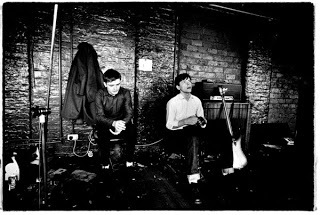 Joy Division was one of four essential post-punk bands that trace their origins to a now-legendary 1976 performance by the Sex Pistols at the Lesser Free Trade Hall in Manchester. Along with founding members of the Buzzcocks, the Smiths and the Fall, Mancunians Bernard Sumner and Peter Hook decided in the immediate aftermath of the Pistol's show to form a band. And while the DIY ethos of the Sex Pistols gave them the wherewithal to call themselves a band when they could barely play their instruments, the band they became was the first punk-inspired group to leave the punk-rock ideology behind. The critical step in that direction was the selection of Ian Curtis from among the respondents to the "Singer Wanted" listing they posted in a local record store. Curtis was less an aspiring rock star than an aspiring poet, and his moody, expressive lyrics veered the group's sound away from thrash and anger and toward something far more spare, speculative and melancholy.
Joy Division was one of four essential post-punk bands that trace their origins to a now-legendary 1976 performance by the Sex Pistols at the Lesser Free Trade Hall in Manchester. Along with founding members of the Buzzcocks, the Smiths and the Fall, Mancunians Bernard Sumner and Peter Hook decided in the immediate aftermath of the Pistol's show to form a band. And while the DIY ethos of the Sex Pistols gave them the wherewithal to call themselves a band when they could barely play their instruments, the band they became was the first punk-inspired group to leave the punk-rock ideology behind. The critical step in that direction was the selection of Ian Curtis from among the respondents to the "Singer Wanted" listing they posted in a local record store. Curtis was less an aspiring rock star than an aspiring poet, and his moody, expressive lyrics veered the group's sound away from thrash and anger and toward something far more spare, speculative and melancholy. The soundscape that Joy Division developed over the course of 1977-79 included the addition of the synthesizer—an absolute violation of the lo-fi punk aesthetic, but a choice that marked the beginning of what would eventually be called the New Wave. Unknown Pleasures and "Love Will Tear Us Apart" made Joy Division cult heroes in the UK, and Ian Curtis's mesmerizing stage demeanor turned him into a post-punk icon.
The soundscape that Joy Division developed over the course of 1977-79 included the addition of the synthesizer—an absolute violation of the lo-fi punk aesthetic, but a choice that marked the beginning of what would eventually be called the New Wave. Unknown Pleasures and "Love Will Tear Us Apart" made Joy Division cult heroes in the UK, and Ian Curtis's mesmerizing stage demeanor turned him into a post-punk icon.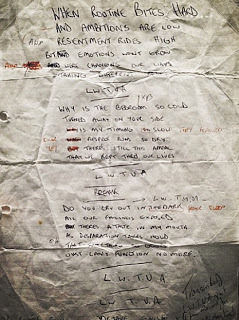 Ian Curtis Handwritten LyricsThough he concealed his condition from his bandmates until he suffered a major seizure in their tour van following a gig in December 1978, Curtis was an epileptic. Some have speculated that depression over his worsening medical condition or the side effects of his medication led to Curtis's suicide. Whatever his reasons, Ian Curtis took his own life just two days prior to Joy Division's planned departure on a potentially career-changing tour of America. Two months after Curtis committed suicide, the surviving members of Joy Division fulfilled a promise they'd made to one another by retiring their group's name and continuing on through the 80s with the name New Order.
Ian Curtis Handwritten LyricsThough he concealed his condition from his bandmates until he suffered a major seizure in their tour van following a gig in December 1978, Curtis was an epileptic. Some have speculated that depression over his worsening medical condition or the side effects of his medication led to Curtis's suicide. Whatever his reasons, Ian Curtis took his own life just two days prior to Joy Division's planned departure on a potentially career-changing tour of America. Two months after Curtis committed suicide, the surviving members of Joy Division fulfilled a promise they'd made to one another by retiring their group's name and continuing on through the 80s with the name New Order.Bassist, Peter Hook recalls: "After something like that, you don't know what to do. The only thing constant in our lives was practice. When we left Ian's funeral we said: 'See you at practice.' That Sunday afternoon I got the six-string riff to 'Dreams Never End,' which we recorded as New Order. We just put Joy Division in a box and closed the lid, but it enabled the remaining three of us to establish ourselves as New Order. Through New Order people continued to become aware of Joy Division.
 "I know Joy Division will always be overshadowed by Ian's death. I remember driving to the tax office to tax my old £100 Jag when the chart rundown went: In at No 11, Joy Division with 'Love Will Tear Us Apart.' I turned it off. For us, Joy Division had gone.
"I know Joy Division will always be overshadowed by Ian's death. I remember driving to the tax office to tax my old £100 Jag when the chart rundown went: In at No 11, Joy Division with 'Love Will Tear Us Apart.' I turned it off. For us, Joy Division had gone."I think, as with Kurt Cobain much later, it was the death of innocence. Ian's daughter didn't have a father. Did independent music gain an icon? I'm too close to it. I had to view the death of Joy Division as a new start. All the battles we went through in Joy Division, we had to go through once again.
"Listening to Closer again, it's heart-rending. Ian created a wonderful testimony of how he felt at the time: apprehensive, fearful, but powerful. Not in control of your destiny: you can hear how that break evolved."

Published on May 31, 2018 06:20
May 30, 2018
Will Love Tear Us Apart?
Ian Curtis wrote "Love Will Tear Us Apart," his melancholy post-punk classic on the inevitable dissolution of a failing relationship, in August 1979. It's a clear contrast to the boisterous aggression that marked early punk, with languid, hopeless vocals and bleak lyrics. The song became his epitaph, and Joy Division's. By May 1980, Curtis had taken his own life, "Love Will Tear Us Apart" chiseled on his headstone. Joy Division floundered for a while and reformed as seminal post-punk band New Order. In the more than three decades since Curtis wrote the tune into the rock 'n' roll pantheon, it's been covered a thousand times. But Gordon Calleja and Mighty Box have shifted mediums entirely and turned “Love Will Tear Us Apart” into a game.
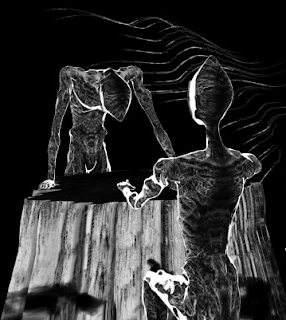 Will Love Tear Us Apart is a videogame adaptation of Joy Division's dirge-pop standard and there's nothing else quite like it. The art is grim and hand-drawn, the color palette starkly monochromatic, the gameplay strangely (and intentionally) unsatisfying. A playthrough clocks in at about the length of an EP, and in that time WLTUA recreates the emotions of a doomed relationship with the game mechanics of three dramatically different genres (one based on each verse of the song): a rock-paper-scissors puzzle, a fiendishly difficult Pac-man-esque maze chase, and a first-person exploration of an emotional landscape. Developed by the Malta-based Mighty Box from a design concept by games academic Gordon Calleja, WLTUA doesn't try to inspire feelings of triumph and accomplishment in its players. Instead, Calleja & co. strived to mimic the emotions of frustration and loss on the melancholy path to a breakup. In the first puzzle, the player sits across from his/her significant other and each chooses to understand, cajole, or angrily dominate the partner.
Will Love Tear Us Apart is a videogame adaptation of Joy Division's dirge-pop standard and there's nothing else quite like it. The art is grim and hand-drawn, the color palette starkly monochromatic, the gameplay strangely (and intentionally) unsatisfying. A playthrough clocks in at about the length of an EP, and in that time WLTUA recreates the emotions of a doomed relationship with the game mechanics of three dramatically different genres (one based on each verse of the song): a rock-paper-scissors puzzle, a fiendishly difficult Pac-man-esque maze chase, and a first-person exploration of an emotional landscape. Developed by the Malta-based Mighty Box from a design concept by games academic Gordon Calleja, WLTUA doesn't try to inspire feelings of triumph and accomplishment in its players. Instead, Calleja & co. strived to mimic the emotions of frustration and loss on the melancholy path to a breakup. In the first puzzle, the player sits across from his/her significant other and each chooses to understand, cajole, or angrily dominate the partner.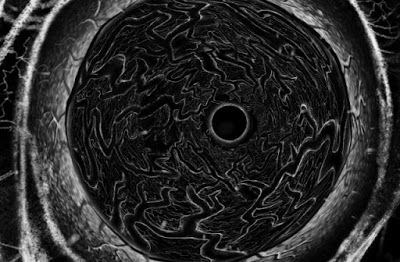 While each verse is represented by a different game genre, the strong and distinctly creepy art style ties the work together as a whole, and each level is tied together by impressive animation sequences. The game starts by transforming a series of wave-forms (a clear reference to Joy Division’s iconic Unknown Pleasures album artwork) into a landscape where the first verse-game takes place. The second level challenges the player to control both members of the doomed relationship simultaneously through two different mazes, a reinterpretation of Curtis' "And we’re changing our ways / taking different roads." The final stage puts the player in a desolate first-person black and white landscape and guides them to the conclusion of the relationship entirely by sound.
While each verse is represented by a different game genre, the strong and distinctly creepy art style ties the work together as a whole, and each level is tied together by impressive animation sequences. The game starts by transforming a series of wave-forms (a clear reference to Joy Division’s iconic Unknown Pleasures album artwork) into a landscape where the first verse-game takes place. The second level challenges the player to control both members of the doomed relationship simultaneously through two different mazes, a reinterpretation of Curtis' "And we’re changing our ways / taking different roads." The final stage puts the player in a desolate first-person black and white landscape and guides them to the conclusion of the relationship entirely by sound.The grotesque hand-drawn graphics and sound-alike score go a long way in transmitting the texture of "Love Will Tear Us Apart," but the game's most intriguing achievement is the imperfect translation of Curtis' hopeless lyrics into game mechanics. While "Love Will Tear Us Apart" is an inevitable statement to be received passively and without hope, Will Love Tear Us Apart? asks the player to answer the question, and struggle through the dying embers of a romantic flame.
Published on May 30, 2018 15:35
Closer - The 9 Circles of Hell - Joy Division
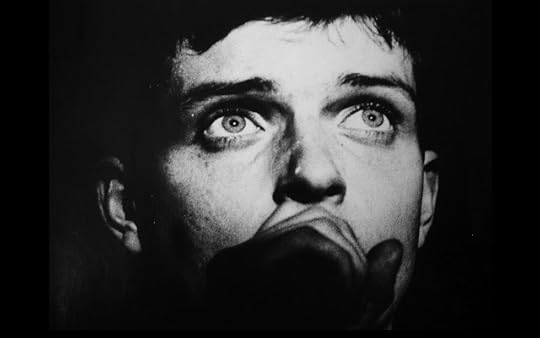 In the beginning, Joy Division was a punk band. Their first EP, An Ideal For Living, recorded in December '77, shows no sign of the doom and depression that would permeate their music a year later. Ian Curtis, like Paul's one, two three four, in "I Saw Her Standing There" signaling the Beatles arrival on the scene, opens the EP with the odd, "3-5-0-1-2-5, GO!" It was punk's version, 15 years on, with no less impact. Ian's lyrics are angry and frustrated, rather than fatalistic, with Sumner playing the wildest, fastest, sloppiest licks of his career on "Warsaw" and "Failures." Indeed, for all the negative energy released during the punk era, it took the movement a good two years before it started generating genuinely bleek, depressed, when-will-it-end music, you know, Joy Division.
In the beginning, Joy Division was a punk band. Their first EP, An Ideal For Living, recorded in December '77, shows no sign of the doom and depression that would permeate their music a year later. Ian Curtis, like Paul's one, two three four, in "I Saw Her Standing There" signaling the Beatles arrival on the scene, opens the EP with the odd, "3-5-0-1-2-5, GO!" It was punk's version, 15 years on, with no less impact. Ian's lyrics are angry and frustrated, rather than fatalistic, with Sumner playing the wildest, fastest, sloppiest licks of his career on "Warsaw" and "Failures." Indeed, for all the negative energy released during the punk era, it took the movement a good two years before it started generating genuinely bleek, depressed, when-will-it-end music, you know, Joy Division.  That the band ultimately named itself Joy Division, referring to the Jewish girls in House of Dolls, was not itself indicative, considering the frequent fascination of punk bands, beginning with the Sex Pistols, with Nazi imagery, for shocking allegorical purposes. The Joy Division being the name given the dorm of women, mostly young girls, spared from the gas chamber for the sexual pleasure of Nazi soldiers. But as long as the band was named Warsaw, they played routine, derivative punk; the name change accompanying a major stylistic shift, opening the floodgates for legions of bands in their wake. Joy Division was that split that divided pure punk from post-punk, Goth, grunge, alt-rock, emo, you name it; the fact remains that Joy Division simply had no competition in the arena of bleak pop sans The Cure. Modern rock begins then with Unknown Pleasures. Recorded over the first two weeks of April 1979, in Stockport's Strawberry Studios (set up by 10cc), Unknown Pleasures had a Doors-like hierarchy: Ian Curtis as the lyricist and vocalist, the three bandmates writing and recording the music around his shamanism. (It's interesting to compare this to Waters in The Wall, as well.)
That the band ultimately named itself Joy Division, referring to the Jewish girls in House of Dolls, was not itself indicative, considering the frequent fascination of punk bands, beginning with the Sex Pistols, with Nazi imagery, for shocking allegorical purposes. The Joy Division being the name given the dorm of women, mostly young girls, spared from the gas chamber for the sexual pleasure of Nazi soldiers. But as long as the band was named Warsaw, they played routine, derivative punk; the name change accompanying a major stylistic shift, opening the floodgates for legions of bands in their wake. Joy Division was that split that divided pure punk from post-punk, Goth, grunge, alt-rock, emo, you name it; the fact remains that Joy Division simply had no competition in the arena of bleak pop sans The Cure. Modern rock begins then with Unknown Pleasures. Recorded over the first two weeks of April 1979, in Stockport's Strawberry Studios (set up by 10cc), Unknown Pleasures had a Doors-like hierarchy: Ian Curtis as the lyricist and vocalist, the three bandmates writing and recording the music around his shamanism. (It's interesting to compare this to Waters in The Wall, as well.)Chart impact of the album was imperceptible (#71 on the UK charts, and not released overseas at all due to the complete lack of promotion or even any singles to accompany the record). Reviews were largely positive, but Unknown Pleasures, and Joy Division in general were, cultivated a posteriori, when depressed grungers and alt-rockers kicked out the Style and brought back The Jam; here were the new flagbearers of guitar-based popular music. (“God bless mummy and daddy, and please, God, you made it happen once, let it happen again, Amen.)
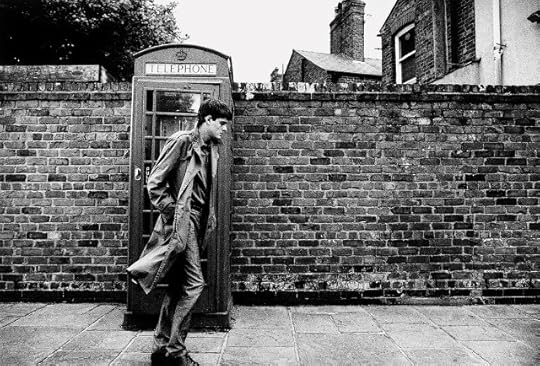
o o o
Unlike Unknown Pleasures, Closer takes time to set in. The songs are slower, longer, more repetitive, less flashy, and even more dependent on atmosphere — not a comfortable kind of atmosphere, either. A kind of atmosphere created by a 24-year old man with the mind of an 80-year old recluse, fed up with and let down by all of earthly pleasures, Closer is an album about the end of The World — where The World is understood from a purely personal perspective.
Interestingly, Closer sold far better than Unknown Pleasures, despite it lack of accessibility. In comparison, Closer, which went all the way to No. 6 on the UK charts, is a far more difficult album. Of course two factors led to its ultimate success: the suicide of Ian Curtis on May 18, 1980, which made the reclusive and deranged frontman one of the most talked about people in Britain, and the release of "Love Will Tear Us Apart" as a single in June: the song, became a smash hit, and certified both the ensuing success of Closer and the Ian-less Joy Division as New Order.
Although the record did not originate as an intentionally conceptional suite, common thematic threads run through it, and the overall flow is nearly perfect. Straight off the listener is beckoned: "This is the way, step inside," and there is little doubt as to the location of the place to which we are invited. Closer is Ian's personal journey through the Nine Circles of Hell, and you could probably attach a special name to each one — just off the top of my head, here's a try: Cruelty (ʻAtrocity Exhibitionʼ), Loneliness (ʻIsolationʼ), Madness (ʻPassoverʼ), Seclusion (ʻColonyʼ), Disillusionment (ʻA Means To An Endʼ), Fatalism (ʻHeart And Soulʼ), Agony (ʻTwenty Four Hoursʼ), Mourning (ʻThe Eternalʼ), and, finally, Cosmic Grief (ʻDecadesʼ). In other words, a fairly jolly party record, this one — do not forget to bring it to all the birthdays and weddings you are invited to, just to remind people of, you know, that other side of the coin.

Published on May 30, 2018 06:12
May 29, 2018
A Stacked Plot of Radio Signals From a Pulsar - CP1919 - A Brief History, 1919 - 1979

1. The Cambridge Encyclopaedia of Astronomy,edited by Simon Mitton. Prentice-Hall of Canada, by Terwin Copplestone Publishing, 1977. No source credit for the plot can be found in the text, other than a general book-wide "diagrams and graphs by Michael Robinson" nod. There's a four-page summary about pulsars and several diagrams but not much detail about the stacked plot itself, beyond the figure caption: "Successive pulses from the first pulsar discovered, CP 1919, are here superimposed vertically. The pulses occur every 1.337 seconds. They are caused by a rapidly spinning neutron star."
2. Graphis Diagrams: The Graphic Visualization of Abstract Data, edited by Walter Herdeg, The Graphis Press, Zurich, 1974. Included in a catalogue of data visualizations on scientific topics, attributed on the credits page to the Arecibo Radio Observatory: "Von einem Computer erzeugte illustration von achtzig aufeinanderfolgenden Pulsperioden des ersten Pulsars, der beobachtet wurde. Die Durchschnittsbreite der Pulse ist weniger als eine 50tausendstel-Sekunde. Das Diagramm wurde vom Arecibo Radio-Observatorium in Puerto Rico hergestellt. Aus Scientific American, 'The Nature of Pulsars,' von J. P. Ostriker (U.S.A.)." A translation includes the definition of a Pulsar: Pulsars are types of neutron stars; the dead relics of massive stars. What sets pulsars apart from regular neutron stars is that they're highly magnetized, and rotating at enormous speeds. Astronomers detect them by the radio pulses they emit at regular intervals.
3. “The Nature of Pulsars” by Jeremiah P. Ostriker, Scientific American, January 1971 (pages 48-60); Credited to Arecibo Radio Observatory in the issue's illustration credit box on page 4.
 4. Joy Division, Unknown Pleasures, 1971 (AM10). In the infinite debate of influence or confluence, Joy Division's place is as secure as its equally esteemed mythos, yet the lens of mythology ofttimes blurs the cruel and unforgiving nature of reality, ignoring the context that was responsible for the music we were enjoying in the first place. Though viewed as the catalyst for what would become New Order, the death of Ian Curtis is no less tragic even when cast in the positive light of his unparalleled influence. And while New Order's acclaim and success is deserved and historic in its own right, the band's clear distinction both in sound and in scope separate it from the overwhelming, albeit brief, presence of Joy Division.
4. Joy Division, Unknown Pleasures, 1971 (AM10). In the infinite debate of influence or confluence, Joy Division's place is as secure as its equally esteemed mythos, yet the lens of mythology ofttimes blurs the cruel and unforgiving nature of reality, ignoring the context that was responsible for the music we were enjoying in the first place. Though viewed as the catalyst for what would become New Order, the death of Ian Curtis is no less tragic even when cast in the positive light of his unparalleled influence. And while New Order's acclaim and success is deserved and historic in its own right, the band's clear distinction both in sound and in scope separate it from the overwhelming, albeit brief, presence of Joy Division.Perhaps the most profound and uncanny part of Joy Division's story is found in the band's vapor-like existence, spanning only two full-length albums and an EP. It's the kind of story the world of rock 'n' roll readily mutates into lore, with the spectacle unfairly overshadowing the validity of the music itself. The song that arguably started it all (notwithstanding, of course, the single-only icon "Love Will Tear Us Apart," AM10), is unmistakably "Disorder." The first track from Joy Division’s debut LP immediately kicks in the obliquely subdued soundscape the band would pioneer. Beginning with Stephen Morris' hiccuped drums and Bernard Sumner's minimal guitar work, the song's pace is exacting, gradually unraveling both lyrically and musically, with Ian Curtis' icy baritone punctuating the song's staccato rhythm (and possibly mimicking his epilepsy). The song's gradual descent into sonic disarray is something that might have detracted from any other band whose vocalist wasn't Ian Curtis. He reverberates the word "feeling" in a fevered, isolated haze to close the song and to essentially begin and even end Joy Division’s tragic and influential story. "I’ve been waiting for a guide to come and take me by the hand" remains a startling opening line for any album. When Curtis wrote it he was emerging from an adolescent worship of decadent rock poets such as Iggy Pop, Lou Reed and David Bowie, yet the line contains none of their bravado. Hindsight has robbed Curtis of much of his poetic genius. Today his lyrics are analyzed in reference to his suicide, they should really be read in deference to a young man in love with rock 'n' roll and suffering from a debilitating illness. Or maybe just from a young man.
Clear, stark and darker than night, "She's Lost Control" is one of the group's finest recordings. Disembodied, Ian Curtis' voice sits uncomfortably in the middle, intoning the lyrics that would come to define his battle with epilepsy. "New Dawn Fades," is perhaps the summation of the atmosphere of dread that exists on Unknown Pleasures. Defying description, the album seems to scream against an unknown terror. Half in love with darkness, Joy Division seem terrified of being consumed by it. Driven by a thick bassline from Peter Hook, the mathematical beats of Stephen Morris and the restrained guitar playing of Bernard Sumner, the track takes the dark tones of The Velvet Underground and melts them into thick black tar. When Curtis intones "a loaded gun won’t set you free" he may have had one eye on his own fate, but he was also looking at a country fast falling apart. Terrorist attacks at home and abroad, a government brought to its knee by militants, and Curtis in the middle "hoping for something more." It was the Clash with sorrow rather than anger.
Published on May 29, 2018 01:31
Unknown Pleasures - Oddly, Six Months Before The Wall
Through a glass darkly you see her with an Unknown PleauresT, hot as hell, jeans shorts, big black belt, black eye shadow, and she's outside Vinyl Fetish on Melrose and you feel stupid cause you bought Duran Duran's "Girls on Film" and you think she'll think you're a poseur, worse, but she smiles like a frown and you walk down Melrose and she's got chili on her chin from a Pink's hot dog and you wipe it off and lick your finger and she says something funny and you realize she's the poseur 'cause she’s all gloomy Gus on the outside, but all smiley unicorns really, and not the girl you thought you'd impress only if you made a suicide pact 'cause you couldn't be together 24/7. That's what happens when you read too much into something.
 I don't call, but I run into her coming down the escalator in Bullock's Westwood. I was going up. She came up again and I went down. I took her to dinner. I took her home.
I don't call, but I run into her coming down the escalator in Bullock's Westwood. I was going up. She came up again and I went down. I took her to dinner. I took her home. In the morning we went to the Glen Market. We bought salads and cold cuts and fresh rolls. We stopped at a house down the street and bought half an ounce. We made a fire. I read to her: Bukowski, Love is a Dog From Hell. We watched TV. We made love. We smoked a lot of dope. We ate. We listened to Unknown Pleasures over and over: "Feeling, feeling, feeling, feeling, feeling, feeling, feeling."
We listened to "Boys Don't Cry" and David Bowie's Low. We danced. I wrote a poem about her pussy. It wasn't any good. She let me finish in her mouth. We giggled. We ate. We smoked a lot of dope.
On the third day we slept till the afternoon. We watched the news. There was a picture of a missing girl. We were having breakfast for dinner and I was in the kitchen. She said, "That's me!" The bacon was sizzling. The windows were open. It was the time of day when everyone in the Valley was headed home to the city and everyone in the city was headed home to the Valley. "Did you hear me?"
"Huh?" "I'm on the news." "You're on the news?" "I'm on the news." "What did you do?" "I'm missing." "You're not missing." "Right? Am I not right here?" "Where’d you go?" "Shhhh. I'm missing." "For real?" "Yes." "Should we let someone know?" "My father, maybe." "Now." "Not now. Tomorrow." "Tomorrow?" "Are you hungry?" "Famished." "Let's eat." "Put on Talking Heads." "From the desert to the sea to all of Southern California, good night." It was The Big News. "Good night, Gerry Dunphy." "Fuck me." In the morning she called her father. "I'm not missing. I wasn't missing." She made mocking faces. She said, "When I get there," and hung up the phone. "He can’t trust me at all? I gotta be on the news?" I never saw her again.
0 0 0
It's nearly 40 years since that day. I never saw her again, but I can relive it, nonetheless, like it was yesterday, if only I listen to Unknown Pleasures, the music that fresh, that alive, like Yeats or like cummings. This was an album that launched a million stories. This one was mine.
 "Disorder" with its swirling soundscape is evidence of how quickly the band had developed since Warsaw. "Day Of The Lords" is a stunner. Brooding, a menace roiling, holding off. "Candidate" is densely atmospheric. Forget the post-punk label. This is art in music. "Insight" hints at the synthetic direction New Order would take, electronica, nonetheless, pushed firmly aside by an achingly melancholic Ian Curtis vocal.
"Disorder" with its swirling soundscape is evidence of how quickly the band had developed since Warsaw. "Day Of The Lords" is a stunner. Brooding, a menace roiling, holding off. "Candidate" is densely atmospheric. Forget the post-punk label. This is art in music. "Insight" hints at the synthetic direction New Order would take, electronica, nonetheless, pushed firmly aside by an achingly melancholic Ian Curtis vocal. As good as Unknown Pleasures is thus far, a bench mark to end all bench marks is set: "New Dawn Fades" opens with bits of backward guitar-detritus, turning left into a requiem sung by a 20-year-old for his own life, utterly resigned and moving. And that would be enough, but towards its end the track shifts up a gear, climaxing like no other song in rock; despair expiated. Again, this one will have your hair standing on end, a hush vocal from Ian Curtis, a soft washing guitar, the drums picking up so slowly that you don't even realize, building into a powerhouse of sound. Bass and vocal lock and neck hairs flex.
"New Dawn Fades" hits with the Shock of the New. All these years later, it seems thrown from the void, fully-formed and unprecedented, new each time (perhaps its nearest relative is "Tomorrow Never Knows"). "She's Lost Control," from its electronic style and bass in your face punch, is the most accessible track. The flutter of the music paints the image of Curtis dancing jerkily in your mind's eye. "Shadowplay" follows some kind of imagined urban murder, charging through neon-lit darkness on the back of Sumner/Albrecht's guitar: alternatively chordally violent or flying through systemic solos that cycle like Reich or Glass, this will make your heart race faster. "Wilderness" is more soundscape. Dreamy. Somehow it's all over the place yet ordered. "Interzone" picks up faster. That bass. (Fuck.) The vocal more like earlier Joy Division. "I Remember Nothing" will make you jump out of your skin. So quiet, then those crashes. The longest track closes the LP in fitting style. Moody. Gothic.
Unknown Pleasures hit the lofty heights of No. 71 on the U.K. Album Charts. Imbeciles. One of only two studio albums by Joy Division, it was, and is, an LP with few peers.
o o o
I think there's a great dichotomy here. Next to Unknown Pleasures, and thinking back now, The Wall is so out of place. Progressive Rock had come crashing down; Yes was no longer Close to the Edge but Tormato, sigh, Gentle Giant had come to the Missing Piece, awful, and Love Beach, heavens. But Pink Floyd had Animals, and plundered on, amidst disco and Sex Pistols; a great feat in the face of adversity. The critics were falling all over Darby Crash and Circle Jerks and bands that couldn't play their instruments, but somehow Pink Floyd put up The Wall. Still, the juxtaposition of Unknown Pleasures and The Wall is hard to digest.
Published on May 29, 2018 00:58
May 28, 2018
Atmosphere
 A frightening video went viral on Twitter a year or so back, a creepy black and white version of the U.K. children's program Teletubbies. Spawned by a leaked black and white photo, the mash-up video of Joy Division's "Atmoshere" is from Christopher G. Brown, and it just works. It's more frightening than the original and you'll never think of La La and Po the same way again - indeed, watch the video and ruin your childhood. Teletubbies in black and white are the 10th circle of hell. Click here, if you dare.
A frightening video went viral on Twitter a year or so back, a creepy black and white version of the U.K. children's program Teletubbies. Spawned by a leaked black and white photo, the mash-up video of Joy Division's "Atmoshere" is from Christopher G. Brown, and it just works. It's more frightening than the original and you'll never think of La La and Po the same way again - indeed, watch the video and ruin your childhood. Teletubbies in black and white are the 10th circle of hell. Click here, if you dare.
Published on May 28, 2018 17:13
Made a Victim of Your Life - Warsaw and Joy Division
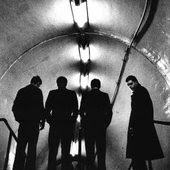 The Warsaw story begins on July 20, 1976, when the Sex Pistols played at the Lesser Free Trade Hall in Manchester, supported by local bands Slaughter and the Dogs, and the Buzzcocks (making their debut). As the legend goes, the gig inspired the boys to buy guitars and form a band, of course it did. Although the truth may be less dramatic, there is no doubt the event stimulated the Manchester music scene in general and the future members of Joy Division in particular. Barney Sumner and Peter Hook went to the gig with their friend Terry Mason. The three of them, who had been at school together in Salford, had seen the Sex Pistols at an earlier show on June 4th. As Barney already had a guitar, Hooky acquired a bass. Terry attempted to play drums without success. What the boys lacked was a singer.
The Warsaw story begins on July 20, 1976, when the Sex Pistols played at the Lesser Free Trade Hall in Manchester, supported by local bands Slaughter and the Dogs, and the Buzzcocks (making their debut). As the legend goes, the gig inspired the boys to buy guitars and form a band, of course it did. Although the truth may be less dramatic, there is no doubt the event stimulated the Manchester music scene in general and the future members of Joy Division in particular. Barney Sumner and Peter Hook went to the gig with their friend Terry Mason. The three of them, who had been at school together in Salford, had seen the Sex Pistols at an earlier show on June 4th. As Barney already had a guitar, Hooky acquired a bass. Terry attempted to play drums without success. What the boys lacked was a singer.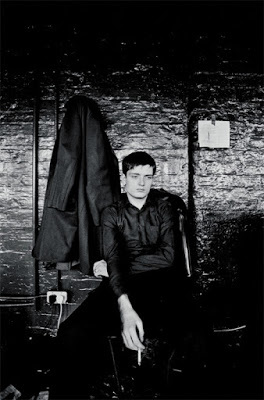 Ian Curtis was at the gig as well, along with his wife, Deborah. Ian was interested not only in the music, but also in lyric writing, and he too was trying to form a band. He already knew Barney, Peter and Terry from various gigs they'd attended in Manchester, and when he made contact to inquire about gainful employ, everything fell into place. On December 28, 1976 the Buzzcocks recorded their Spiral Scratch EP, produced by Martin Hannett and considered by many a major landmark in the development of the Manchester music scene. Ian got to know the Buzzcocks, particularly Pete Shelley and their manager, Richard Boon, and was motivated to emulate their success.
Ian Curtis was at the gig as well, along with his wife, Deborah. Ian was interested not only in the music, but also in lyric writing, and he too was trying to form a band. He already knew Barney, Peter and Terry from various gigs they'd attended in Manchester, and when he made contact to inquire about gainful employ, everything fell into place. On December 28, 1976 the Buzzcocks recorded their Spiral Scratch EP, produced by Martin Hannett and considered by many a major landmark in the development of the Manchester music scene. Ian got to know the Buzzcocks, particularly Pete Shelley and their manager, Richard Boon, and was motivated to emulate their success.Little is documented about the fledgling band in early 1977. During this period they used to rehearse at the Black Swan pub in Salford, among other venues. Although they now had a full complement, they were not ready for public performances. Neither did they have a name. Stiff Kittens was proposed by Richard Boon (the idea is also credited to Pete Shelley) but this was never adopted by the band. In fact they disliked the name, which was used only to publicize their first gig because they had to be called something. The band was due to appear at Manchester's Electric Circus on May 29, 1977 on a bill which included the Buzzcocks. Just before this gig, they decided on the name Warsaw, inspired by the song Warszawa on David Bowie's Low. They had also managed to recruit a drummer, Tony Tabac. Their first performance earned them a mention (not entirely favorable) in NME. At that time Martin Hannett was involved in arranging gigs for local bands, and he took Warsaw on the books. During June '77 Warsaw made a number of appearances at The Squat and at the Rafters Club in Manchester.
From the start Warsaw set out to write their own songs. Their initial efforts were crude but enthusiastic, and were soon left behind as they became more practiced. This meant that very little material from this early period survived long enough to be recorded. Prompted by Curtis, the band's musical influences and ambitions inclined more towards The Velvet Underground and Iggy Pop than "mainstream" rock.

In December '77, Warsaw recorded four songs that later would be released on EP as An Ideal For Living. It was very much a home-made affair, with the band members and their friends stuffing the records into their sleeves. The design (by Bernard) featured Germanic imagery that fueled unjustified speculation about the band's politics. Ah, back when Joy Division was raw and reckless. "Warsaw" is fast, powerful and ends in a bang. "No Love Lost" shows Curtis experimenting with his vocals. "Leaders of Men" is the star here. "Born from some mother's womb/ Just like any other womb/ Made a promise for a new life/ Made a victim out of your life." This was Joy Division (or maybe more properly, Warsaw) at their most ferocious. We think of '76 as Joni at her best, Genesis without Gabriel, The Eagles Greatest Hits, Wings at the Speed of Sound and "Bohemian Rhapsody." Not many were aware that a revolution was upon us, even though in retrospect they claim they were right there where it started.
Published on May 28, 2018 05:04



